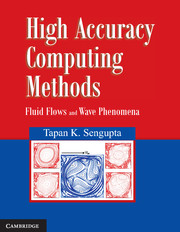Book contents
- Frontmatter
- Contents
- Foreward
- Preface
- Chapter 1 Basic Ideas of Scientific Computing
- Chapter 2 Governing Equations in Fluid Mechanics
- Chapter 3 Classification of Quasi-Linear Partial Differential Equations
- Chapter 4 Waves and Space–Time Dependence in Computing
- Chapter 5 Spatial and Temporal Discretizations of Partial Differential Equations
- Chapter 6 Solution Methods for Parabolic Partial Differential Equations
- Chapter 7 Solution Methods for Elliptic Partial Differential Equations
- Chapter 8 Solution of Hyperbolic PDEs: Signal and Error Propagation
- Chapter 9 Curvilinear Coordinate and Grid Generation
- Chapter 10 Spectral Analysis of Numerical Schemes and Aliasing Error
- Chapter 11 Higher Accuracy Methods
- Chapter 12 Introduction to Finite Volume and Finite Element Methods
- Chapter 13 Solution of Navier–Stokes Equation
- Chapter 14 Recent Developments in Discrete Finite Difference Computing
- Exercises
- References
- Index
Chapter 1 - Basic Ideas of Scientific Computing
Published online by Cambridge University Press: 05 January 2014
- Frontmatter
- Contents
- Foreward
- Preface
- Chapter 1 Basic Ideas of Scientific Computing
- Chapter 2 Governing Equations in Fluid Mechanics
- Chapter 3 Classification of Quasi-Linear Partial Differential Equations
- Chapter 4 Waves and Space–Time Dependence in Computing
- Chapter 5 Spatial and Temporal Discretizations of Partial Differential Equations
- Chapter 6 Solution Methods for Parabolic Partial Differential Equations
- Chapter 7 Solution Methods for Elliptic Partial Differential Equations
- Chapter 8 Solution of Hyperbolic PDEs: Signal and Error Propagation
- Chapter 9 Curvilinear Coordinate and Grid Generation
- Chapter 10 Spectral Analysis of Numerical Schemes and Aliasing Error
- Chapter 11 Higher Accuracy Methods
- Chapter 12 Introduction to Finite Volume and Finite Element Methods
- Chapter 13 Solution of Navier–Stokes Equation
- Chapter 14 Recent Developments in Discrete Finite Difference Computing
- Exercises
- References
- Index
Summary
Applied computer science is now playing the role which mathematics did from seventeenth to twentieth centuries: providing an orderly formal framework and exploratory apparatus for other sciences
- I. Foster (2006).Overview on Scientific Computing
The quotation above encapsulates the role scientific computing is expected to play now. Introduction of calculus in seventeenth century provided revolutionary changes in understanding the physical world by analysis and quantification in various branches of science. Prehistory of computing begins with activities in two fronts.
Charles Babbage (1791–1871) laid out detailed plans of mechanical calculating machines: (i) Difference Engines (1821) to construct mathematical tables (without incurring human error!) and (ii) Analytical Engines for the more ambitious task of performing any mathematical task with the help of programmed punched cards. Scaled version of Difference Engine was made during his lifetime. Analytical Engines remained at the conceptual level, though many of its features have found place in modern computers.
On the other hand, progresses were made in developing numerical methods. Basic advances in numerical techniques made in previous centuries encouraged Richardson [225] to seek a solution of system of equations for weather forecasting using a desk calculator. Results were not particularly encouraging from this pioneering effort, but the seeds were sown for what was to become a major initiative!
- Type
- Chapter
- Information
- High Accuracy Computing MethodsFluid Flows and Wave Phenomena, pp. 1 - 7Publisher: Cambridge University PressPrint publication year: 2013



